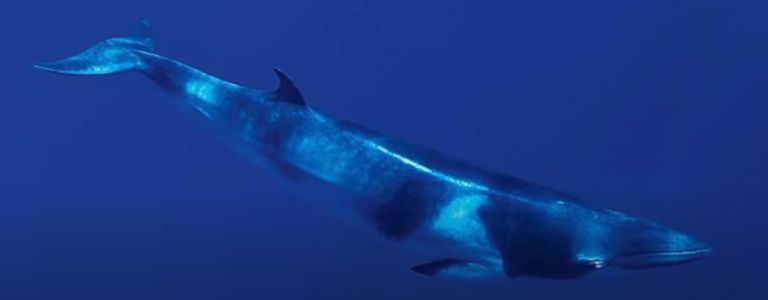
The National Oceanic and Atmospheric Administration (NOAA) has partnered with Google AI to analyze an ocean of long-term passive acoustic data. Using AI and machine learning, they have analyzed in hours what would otherwise take decades to process.
In 2014, an Oregon State University autonomous seaglider survey in the Mariana Archipelago heard a new sound: a mechanical-sounding whale vocalization. They called it a “Biotwang.”
Without visual observers to identify the source of the sound, they guessed that it might be made by a baleen whale, but could not determine the species.
In 2018, NOAA scientists conducted a visual and acoustic survey of marine mammals in the Mariana Archipelago. During the month-long survey, they spotted 10 different groups of Bryde’s whales. In nine of those groups, they also recorded Biotwangs—solving the mystery of the source of the unique call.
NOAA scientists use long-term passive acoustic recorders to monitor the health and status of marine mammal populations. In the North Pacific, they have been deploying bottom-mounted data recorders at 13 locations since 2005.
These recorders have captured more than 500 TB of data or almost 200,000 hours of recordings. If you were to listen to all of that audio straight through it would take nearly 23 years! Because the Biotwang had not been identified before, scientists had no idea where they might find it in this sea of data.
That’s where Google AI stepped in. NOAA scientists worked with Google to use AI and machine learning to analyze the immense passive acoustic monitoring datasets. With the help of AI and machine learning, they were able to identify where and when Biotwangs were recorded in past acoustic data. Thanks to AI they did it in a matter of hours, rather than years. The results of this research were recently published in Frontiers in Marine Science.
This model was part of an open-source multi-species marine mammal vocalization machine-learning classification model. It allowed NOAA to analyze the recordings quickly and efficiently and with a higher level of accuracy than available using traditional methods.
NOAA scientists identified a consistent seasonal presence of Biotwangs only in the Mariana Archipelago and to the east at Wake Island. This suggests the Biotwang may be a call specific to a western North Pacific population of Bryde’s whales. Knowing that Biotwangs are produced by a specific population helps to monitor the distribution of that population.
NOAA observed that the seasonal occurrence of Biotwangs is consistent with Bryde’s whales migrating between low and mid-latitudes. There was a small peak between February and April, and a larger peak between August and November, as the whales travel past the recording sites.
These peaks vary from year to year. There were a lot of Biotwangs in 2016, during a strong El Niño year, and almost none heard in 2021, a La Niña year. We think the whales may be feeding along ocean currents that are strongly influenced by the Pacific Decadal Oscillation. As climate change advances, more frequent and extreme El Niño and La Niña years may cause the productive current to shift poleward and be more variable. This means the whales will have to travel further and work harder to find their food, which can impact the health of the population.
NOAA also partnered with Google in 2018, when they used machine learning to identify humpback whale song in their long-term passive acoustic dataset. They believe that this was the first time a large audio dataset was analyzed in a comprehensive way.
Recording of Bryde’s whale Biotwangs:
